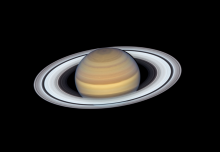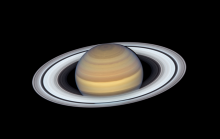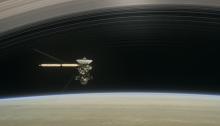The giant planet Saturn keeps company with the Moon tonight. They climb into good view by 10:30 or 11. Saturn looks like a bright star close to the left of the Moon. It’ll stand even closer to the Moon at dawn tomorrow.
Saturn is best known for its beautiful rings. They probably represent the shattered remains of one or more small moons — countless bits of ice from the size of dust grains to boulders.
The major rings span more than two-thirds the distance from Earth to the Moon. But they’re amazingly thin — no more than a few hundred feet thick. And across most of their great span, they’re only about 30 or 40 feet thick.
To put that into perspective, consider this: If you reduced the rings to the length of a sheet of printer paper, they’d be far thinner than the paper. They got so thin as bits of material rammed into each other, grinding them down to smaller and smaller pieces. Each piece settled into its own orbit around Saturn’s equator.
Because the rings are so thin, when we see them edge-on, they all but vanish. That happens every 14 or 15 years, around Saturn’s equinoxes — the start of spring or fall. Northern fall will arrive in May of 2025, so that’s when the rings will next appear edge-on. For now, their angle is pretty shallow, so the view through a telescope isn’t great. Even so, it’s still one of the most amazing sights in the solar system — the incredible rings of Saturn.
Script by Damond Benningfield






